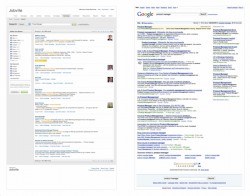![]() Jobvite is introducing what I hesitate to call a new sourcing tool, only because the term doesn’t really do it justice.
Jobvite is introducing what I hesitate to call a new sourcing tool, only because the term doesn’t really do it justice.
Google is a sourcing tool, but while it may get the job done, how long will it take to sift through the results? Jobvite Source is more of a blend of the best attributes of ZoomInfo and Broadlook with access to the social networks as well as the entire Web.
 Last week, during a demo, Chief Product Officer Jamie Glenn did a search for an online marketing manager and came up with the resumes of, maybe, a couple hundred possibles from all the Web’s free sources. A similar search on Google turns up results in the hundreds of thousands.
Last week, during a demo, Chief Product Officer Jamie Glenn did a search for an online marketing manager and came up with the resumes of, maybe, a couple hundred possibles from all the Web’s free sources. A similar search on Google turns up results in the hundreds of thousands.
The difference is Jobvite Source can compare the results to the job req, sifting out the job listings and other stuff, leaving you with resumes that match the requirements. It does the same as a well-structured query to your ATS or a resume database.
Before you say “Yeah, so,” consider that what Jobvite Source does for the job req, it can do for the candidates. Once you’ve compiled the initial candidate list, applied whatever additional filters you want — Glenn limited the search to candidates in the San Francisco Bay Area — and are satisfied, you can toggle over to a view of the candidate and whatever background is available online about them. The compilations are not as extensive as the summaries on ZoomInfo, but they are detailed enough to let you decide whether to look more closely.
Once you’ve narrowed your candidate list, you can import them into your ATS or create a campaign right in Jobvite Source. Either way, you send them a Jobvite, inviting them to apply and letting them know you’re interested. Likewise, any employee can use Jobvite Source to send a personal invitation to friends and connections in their social networks that the technology has matched to the job description.
The candidate contact is the very essence of Jobvite. Says Dan Finnigan, Jobvite CEO, “The Jobvite is the way to engage the candidate.”
Earlier this y ear, Jobvite introduced an application allowing it to access the LinkedIn and Facebook connections of a company’s willing employees. It searches out contacts who best fit the job requirements and suggests to whom a Jobvite ought to be sent. To use it, you had to take the whole Jobvite package. Jobvite Source is a standalone application that works with any ATS.
ear, Jobvite introduced an application allowing it to access the LinkedIn and Facebook connections of a company’s willing employees. It searches out contacts who best fit the job requirements and suggests to whom a Jobvite ought to be sent. To use it, you had to take the whole Jobvite package. Jobvite Source is a standalone application that works with any ATS.
With so many companies moving toward integrated products, Finnigan explained that Jobvite choose to make Source available as a separate product in order to reach that part of the market that already has an ATS and doesn’t have the money or the inclination to switch.
Companies, Finnigan says, have been “obliterating their recruiting departments.” But they still need to fill jobs. He believes that recruiters are moving away from the for-fee resume databases to search for candidates elsewhere. “The world has changed to the open Web,” he says, mentioning all the networks and personal blogs and sites that have cropped up in the last five years. “What we think recruiters need is a way to integrate with all this stuff.”
Jobvite Source, with its automated searching and parsing and filtering, makes it possible for what remains of the recruiting staff — or an HR generalist, in the smaller shops — to source, rather than post and pray. It isn’t going to replace a sourcer like a Shally Steckerl, but there isn’t an employer who wouldn’t welcome a way to cut down on the average recruiter’s time spent looking for candidates.
With a starting price tag of $500 a seat, Jobvite Source can help the SMB market play on a leveler playing field with the bigger firms at a competitive price.